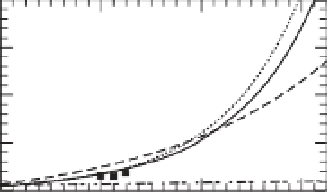Geoscience Reference
In-Depth Information
In contrast, experimental data on deep mantle
minerals are limited.
olivine
+
basalt
20
4.5 Theoretical Studies
10
Due to rapid progress in computational science,
a number of computational studies have been
published on the physical properties of miner-
als. For instance, the computational approach
has played an important role in understanding
elasticity and phase relationships in minerals un-
der the extremely high-pressure conditions (see
Chapter 7, this volume). Similar studies have been
made on plastic properties (for a recent review see
Walker
et al
. (2010)). However, the contributions
from theoretical studies are limited in the area
of plasticity compared to elasticity and phase
relationships. The main reasons are (1) defects
involved in plastic deformation have low sym-
metry and theoretical calculations of relevant
properties are challenging; (2) defect-related prop-
erties are sensitive to impurities such as hydrogen
or oxygen (oxygen fugacity) that are difficult to
calculate; and (3) in many cases, plastic defor-
mation involves multiple aspects and in order to
understand the whole picture, one needs a com-
prehensive study in which the interactions of
many steps are treated appropriately.
For example, Durinck
et al
. (2005) and Oganov
et al
. (2005) calculated the resistance to ho-
mogeneous shear in olivine and post-perovskite
respectively without the concept of a dislocation
and discussed the slip systems. Carrez
et al
. (2007)
calculated the Peierls stress of lower mantle min-
erals based on the theory of crystal dislocations,
and they inferred the dominant slip systems
di-
rectly
from these results. These procedures are
incorrect. Firstly, one needs a concept of crys-
tal dislocations to calculate the resistance for
deformation, and secondly, even if one uses a
concept of a dislocation and calculated some
key parameter such as the Peierls stress, one
needs to consider the role of such a parame-
ter (e.g., the Peierls stress) in high-temperature
creep. For instance, if one uses a classic model of
diffusion-controlled high-temperature creep (e.g.,
0.00
0.04
0.08
0.12
(a)
40
30
20
10
0.00
0.04
0.08
0.12
φ
(b)
Fig. 4.16
Influence of partial melt on deformation of
olivine aggregates (after Kohlstedt, 2002). The
empirical relation
exp (
αφ
)isusedtofitthe
data (
φ
: volume fraction of melt). Reproduced with
permission of Mineralogical Society of America.
ε
(
φ
)
=
ε
(0)
·
a few percent of basaltic melt reduces the creep
strength by more than one order of magnitude
(this corresponds to the enhancement of strain-
rate by more than three orders of magnitude).
The reason for this large discrepancy is not un-
derstood. Jin
et al
. (1994) proposed that the melt
topology under their deformation experiments is
different from the equilibrium geometry. How-
ever, the cause for the different results is not well
understood.
Table 4.2 summarizes the flow laws of typical
minerals. Nearly complete data set is available for
olivine including the influence of temperature,
pressure, water and grain-size. The influence of
partial melting may be included by applying a
correction using Equation (4.19). Although less
complete, extensive data sets are available for
quartz, plagioclase and clinopyroxene (diopside).











